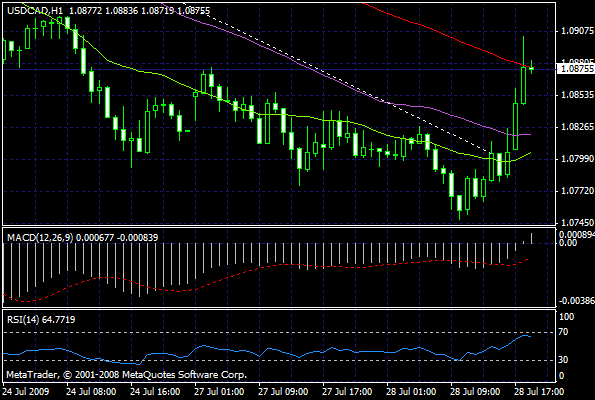Source: ForexYard
The U.S dollar remained weak against its major currencies in range-bound trade on Monday as U.S. equity markets remained in negative territory, indicating waning desire among investors for riskier assets. Also Monday, U.S. and Chinese officials began meeting for two days of economic talks, though many analysts questioned whether anything substantial would emerge. Nevertheless, traders will be on alert for any commentary regarding the U.S. dollar’s status as a reserve currency. China is the biggest foreign investor in U.S. government debt, and any decline in demand could push up borrowing costs.
Economic News
USD – Dollar Goes Volatile on Optimistic Homes Sales Data
The U.S. Dollar experienced an extremely volatile trading day on Monday, as the New Home Sales data was released from the U.S. economy. The result was a better-than-forecast 384,000 homes versus the previous release of 346,000 homes. This is a whopping 11% increase, the biggest monthly increase since December 2000. This led to many analysts stating that this is the end of the U.S. housing slump. The result led to volatile USD trading. Moreover, the Dollar closed lower against some of its main currency pairs, due to optimistic data from regions such as the Euro-Zone.
At one point in trading the USD actually reached a 7-week low vs. the EUR at 1.4299. This was following the extremely optimistic German consumer confidence figures. However, the pair finally closed 33 pips higher at the 1.4246 level. The USD recorded its second daily loss in a row of 30 pips against the British Pound, as the GBP/USD finished trading at the 1.6484 level. This comes about as optimistic data from Britain continues to drive up the British currency. The USD/JPY pair finished higher, to close at the 95.17 rate. This comes about as the Yen falls from higher risk appetite.
Looking ahead to today, forex traders can expect plenty of news coming out of the U.S. The most important of this being the CB Consumer Confidence figures at 14:00 GMT, the speech by Federal Reserve Chairman Ben Bernanke at 22:00 GMT, and the speech by Treasury Secretary Timothy Geithner from 23:00 GMT. These 3 events are set to determine the level of the Dollar as Tuesday’s trading takes off. The big 3 pairs to watch today are the EUR/USD, GBP/USD, and USD/JPY, as traders anticipate a weaker U.S. currency as the U.S. economy continues to recover.
EUR – EUR Boosted by German Consumer Confidence Figures
The EUR hit a 7-week high versus the USD in Monday’s trading, following the Gfk German Consumer Climate figures. The result showed a 14 month high 3.5, significantly higher than the forecasted 2.9. This helped the EUR strengthen throughout Monday’s trading. The reason why this data is so significant is due to Germany being the largest economy in the Euro-Zone. The EUR also was helped as U.S. New Home Sales jumped 11%. The EUR is likely to continue benefiting from the optimistic economic news.
The EUR/USD cross hit 1.4299, before closing 33 pips higher at the 1.4246 level. However, the European currency fell by 15 pips vs. the British Pound to 0.8635. This may be due to investors buying-up Pounds as risk appetite increases with more and more signs of global economic recovery. The EUR/JPY pair climbed by over 35 pips to the 1.3532 level, as traders continued to ditch the JPY due to preferring riskier assets, such as the EUR and GBP. Therefore, overall, the EUR did make some reasonable gains in Monday’s trading.
Today, we won’t be expecting much economic news coming out of the Euro-Zone. However, Britain and Switzerland are likely to be the key drivers of the European currencies later today. Britain is set to release the CBI Realized Sales figures at 10:00 GMT. Switzerland is scheduled to publish the UBS Consumption Indicator at 06:00 GMT. The results of both of these are set to drive both the GBP and CHF in today’s trading. Additionally, the EUR will go volatile on both of these publications, and on key data coming out of the U.S. throughout today’s trading.
JPY – Yen Falls to 3-Week Low vs. Dollar
The Yen fell to a 3-week low against the Dollar yesterday, in response to the rise in new U.S. home sales. The Yen also weakened on speculation that declines in currency volatility will spur carry trades. In carry trades, investors borrow at a low rate in one country and invest in another country with higher returns. This behavior is likely to continue as the main economies improve, and traders sell-off the safe-haven JPY. Thus the Japanese currency fell over 30 pips against the USD, EUR and GBP.
It is likely that the Yen will continue to decline today, as forex traders continue to take into account the optimistic economic data that was published from the U.S. and the Euro-Zone. The JPY will go very volatile in late trading, as Japanese Retail Sales are published at 23:50 GMT. It would be a wise choice for forex traders to open their JPY positions now in order to have the opportunity to profit from volatile market behavior as Tuesday’s trading commences.
Crude Oil – Crude Oil Hits 3-Week High
Crude Oil hit a 3-week high of $68.94 a barrel on Monday, as the USD declined in response to positive housing data from the U.S. However, weaker earnings figures in some instances pushed Oil down from its peak, as the commodity finished trading at about $68.06 a barrel. Crude was also helped by a weaker Dollar in earlier trading due to positive economic news from Germany. However, it seems that in this instance, risk appetite wasn’t strong enough to hold-up the value of Crude Oil on Monday.
As for today, Crude prices may rise if the USD weakens considerably, and there is increasingly optimistic economic news led by the U.S. Additionally, traders need to feel that there is enough demand to support Crude Oil at its current price level. In order to take advantage of the current trends, it is advisable for forex traders to begin opening their positions in Crude Oil and other commodities prior to volatile market conditions.
Technical News
EUR/USD
The latest upward movement has pushed this pair into the over-bought territory on the hourly and daily charts, signaling an impending downward correction. As the price hovers near the upper border of the daily chart’s Bollinger Bands, the downward pressure may be gaining strength. Going short might be a wise choice today.
GBP/USD
Since Friday’s trading session the Cable recouped losses, appreciating to 1.65. The Slow Stochastic of the 4 hour chart is showing no crosses in the horizon, and the bullish momentum there appears to be intact as well. Daily chart’s oscillators also support this notion. Placing long positions might be a right choice for today.
USD/JPY
The hourly and the daily charts indicating that the bullish trend has not yet said its last word as this currency pair is in the midst of a strong upward trend. However the 4 hour chart’s RSI and Slow Stochastic indicators are pointing down. A preferable strategy might be waiting for a clearer signal before entering the market on this pair.
USD/CHF
The pair is continuing its downtrend with full steam, and is now traded around the 1.0690 level. As the current price on the daily chart has dropped beneath the Bollinger Bands’ lower boarder, another bearish session could take place. Going short might be a good strategy today
The Wild Card – NZD/USD
It seems that the bullish momentum is back again as the carry trade pair is heading up with plenty of room to run. All of the technical oscillators on the hourly and the daily charts are giving a bullish signals and this pair’s target today might be the 0.6670 level. This gives forex traders a great opportunity to rejoin the market at an excellent entry price.
Forex Market Analysis provided by Forex Yard.
© 2006 by FxYard Ltd
Disclaimer: Trading Foreign Exchange carries a high level of risk and may not be suitable for all investors. There is a possibility that you could sustain a loss of all of your investment and therefore you should not invest money that you cannot afford to lose. You should be aware of all the risks associated with Foreign Exchange trading.






